Another great shot of the Maverick showing the front and doors off.
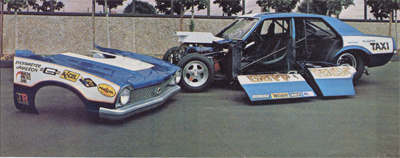
Another great shot of the Maverick showing the front and doors off.

From National Dragster – May 12, 1972
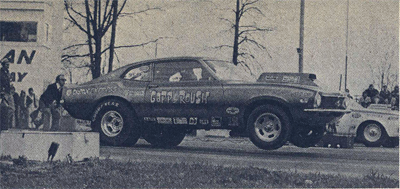
MILAN DRAGWAY, Michigan – Gapp and Roush’s “Shotgun Express” Maverick proved to be the class of the Milan Dragway’s Pro Stock field, as Wayne Gapp pushed the potent FoMoCo entry to a string of 9-second times on his way to an impressive win. Gapp ripped of a 9.69 at 144 mph in the final round to beat Terry Hedrick, who hit a losing 9.90 with his Camaro.
MILAN DRAGWAY, Michigan – Sunday was the day the Pro Stockers invaded Milan Dragway and in spite of the cold weather, there was a large crowd of spectators on hand to witness the action.
In the first round of action, Jim Wick in the “Matchmaker” Duster went up against Terry Hedrick in his “Super Shaker” Camaro. Wick passed through the top end lights first with a time of 9.73 at 142.64, while Hedrick was right on his bumper with a run of 9.90, 141.50. Unfortunately, Wick’s machine lost a master cylinder and ended up in the sand pit, ruining his chances to run the rest of the day.
Next it was the “Shotgun Express” of Gapp and Roush against the Gremlin of Gilbert and Maskin. The Gapp and Roush entry was working perfectly as Wayne Gapp put down a time of 9.79, which was good for a win at 142.86 mph. Rich Maskin is still working “the bugs” out of his brand new Gremlin and was only able to run a 10.10, 134.32. Rich has been one of the most feared competitors in the Modified Eliminator category in Division 3 for several years and when the Gremlin starts to run, watch out!
The final run of round one pitted Ernie McEwen in his Mustang against the Sutka Bros. McEwen on that race hands down with a time of 10.24 at 134.93.
Because of Jim Wick’s mishap, Terry Hedrick took his place in the final round o action. His opponent was to be the “Shotgun Express” of Gapp and Roush. Both drivers staged very carefully and when the lights counted down Gapp and Roush left first and they held their lead to win the honors with a time of 9.69 at 144 mph.
In spite of the coldest spring in 25 years in this part of the country, it looks as if “Drag Racing 1972” is going to be great!
Not many folks get a win at NHRA’s U.S. Nationals. It is considered THE race of the year.
This is from the July 25th 1975 Issue of National Dragster. See the original entry here.
Pro Stock
Of all the evening’s winners, few enjoyed the ceremonies more than Wayne Gapp, the man who has been a frontrunner all year, but seemingly had some trouble with coming through in the final rounds. After losing the Winternationals to Bob Glidden on a holeshot and then fouling to Glidden in the Gatornationals final, Gapp admittedly had been the subject of criticism within the ranks as for his driving expertise, but the skeptics were silenced at this race as he came through in flying colors via a solid trouncing of Bill “Grumpy” Jenkins (8.80 to an 8.93) to claim the win and stop Jenkins’ own personal three-event winning streak at Summernationals events.
A major factor behind the Gapp & Roush win was their frantic engine change between the second and third rounds. After hitting an 8.96 in the first round, Gapp slowed to 9.03 in the second, and concluded that his engine had “gone south.” The subsequent engine change brought forth a resounding 8.84 in the semi’s, setting the stage for his 8.80 thrashing of “the Grump.” The 8.80 was, of course, Low E.T. of the Meet and also a new National Record. Jenkins did have the consolation of setting Top Speed with a clocking of 154.90 mph.
This is a pic, provided to me by Tom Tate, of G & R’s first Pro Stock Maverick. Boss 429 Power. Lot’s of shaking out of the concept and the engine occurred on this vehicle.
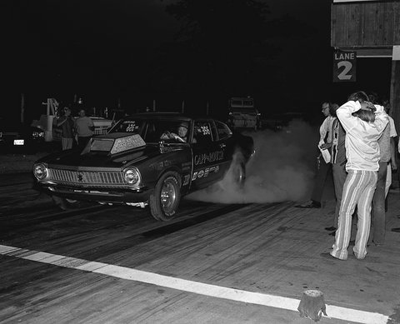
Nice clean shot of the front end of the Maverick showing the engine and the ‘famous’ exhaust plates.
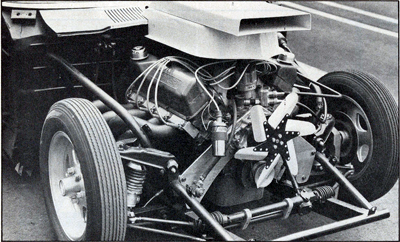
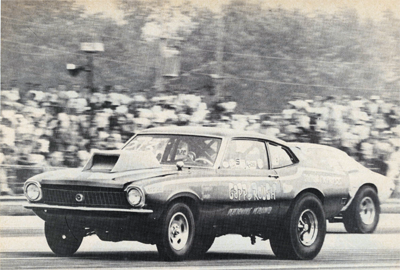
This is from a magazine article titled “Wayne Gapp Builds a Hi-Port-2-Plug-429”. I’ll post the article sometime soon.
Gapp Blasts 9.70 for Indy Pro Stock Win
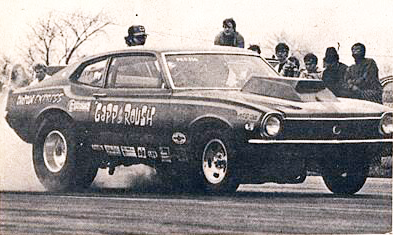
INDIANAPOLIS RACEWAY PARK, Indiana – Gapp and Roush’s “Shotgun Express” Maverick had the Indy Pro Stock field covered, as Wayne Gapp clicked off times of 9.75, 9.76 and finally 9.82, 140.40 mph for the title. His 9.82 in the final round edged Greg Brenneman’s Duster.
– Photo by Jim Campbell
This image is probably from 1971…
The Gapp & Roush race car known as the ‘Taxi’ was built to take advantage of the NHRA rules in effect.
The story itself is a bit twisted both in actual history and in the re-telling over the years.
Let’s see if I can lay out a straight line…so to speak.
First…the rules
In 1973 NHRA Drag Rules the NHRA mandated weight per cubic inch facteos for Pro Stock vehicles were:
Additionally, the rules stated:
Seems pretty straightforward. A legal NHRA small block car would weigh, assuming a engine displacement of 366 cubic inches, 2379 lbs.
A big block car, say a Hemi, would have weighed around 2982 lbs.
An extra 603 pounds was a killer for the big blocks. It becomes obvious why the small block cars were so successful during the 1973 season (in fact continuing their success from 1972).
As my Dad stated in a interview:
Problem was, if NHRA had consulted their physics books they would have realized that it wasn’t all that straightforward. There was a thing called inertia, which no one took into consideration. Simply stated, if you take a 2,700-pound big-block car and a 2,300-pound small-block car and you let out the clutch on each one, it’s the inertia off the line that determines the performance during the first 60-feet of the pass, not the horsepower. In other words, if you kick a cement block and a block of wood, guess which one will travel the farthest? So, naturally, Jenkins’ little Vega just jumped off the starting line and consequently it killed the Chryslers during the 1972 season.”
Going into 1974, needless to say, there were a few complaints. So NHRA tried again.
The 1974 Drag Rules state the following:
Lastly the weight minimums:
Reading THOSE rules and representing Ford vehicles a few things pop out:
So a legal NHRA small block car over 105″ wheelbase would weigh, assuming a displacement of 366 cubic inches, 2360.7 lbs.
A Pinto would weigh 2433.9. So, that is 73 lbs. MORE than the Maverick with the same engine.
A big block car, say a Hemi, would have weighed around 2982 lbs.
The weight advantage of small block (at 105+ inches of wheelbase) vs. big block has gone UP to 621.3 lbs.
So..what happens? NHRA decides that the advantages provided for in the 1974 season need to adjusted. So they go insane adding complexity to the rules in the attempt to achieve parity. At this point, the rules are out of hand.
I have included the relevant set of rules below. See here for all the engine rules.
The new rules state:
The Ford vehicles just got jacked…and the Pinto’s got hammered.
Let’s run our weight calculations again:
In 1973 a small wheelbase Ford could run at: 2379 lbs.
In 1974 a Ford long wheelbase car could run at: 2360.7 lbs.
In 1974 a Ford small wheelbase car could run at: 2470.5 lbs.
In 1975 a Ford long wheelbase car could run at: 2598.6 lbs.
In 1975 a Ford small wheelbase car could run at: 2671.8 lbs.
In 1975 a long-wheelbase small-block Chevrolet could run at: 2525.4
In 1975 a Chrysler Hemi could run at: 3109.8
The difference between the 1974 weight and the 1975 weight was 237.9 lbs. In closing, the performance of the Taxi during 1975 is downright amazing given the attempts by NHRA to factor the vehicle.
Update: There are indeed a couple of different images floating around from this shoot. So no airbrushing!
This is an image that can be seen in several places.
I believe it’s in book called “Mustang Race Cars” and it’s the one that Roush Performance uses here as part of the “About” page for Roush Performance. Except it looks like in that one they airbrushed my Dad’s right arm out of the picture…or he moved and this is not the same shot.
This picture was probably taken in mid to late summer of 1974. The Mustang II was built for that season, so was the Maverick and the Pinto was from ’73.
Anyway, that’s a lot of Pro Stocker’s.
Dad still owns this building by the way.
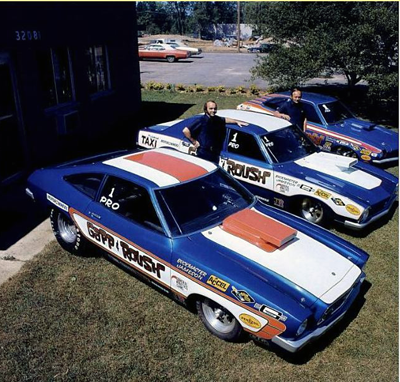
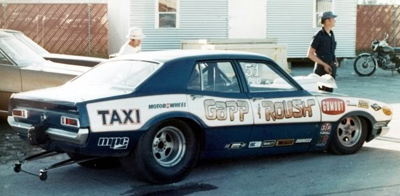
Here is a nice 3/4 angle shot of the ‘Taxi’ showing some good details of the vehicle.
One of the discussions that I have read about over the past is the actual name of the car.
There were three iterations of the name:
I don’t know the reasoning for the name changes. Some of have stated it was pressure from NHRA to change it from ‘Tijuana’ to ‘Juana’ or just plain ‘Taxi’.
I doubt it. The reasons for the changes are lost in time.